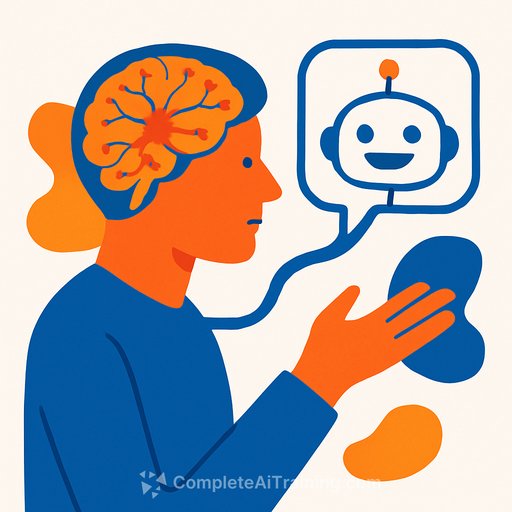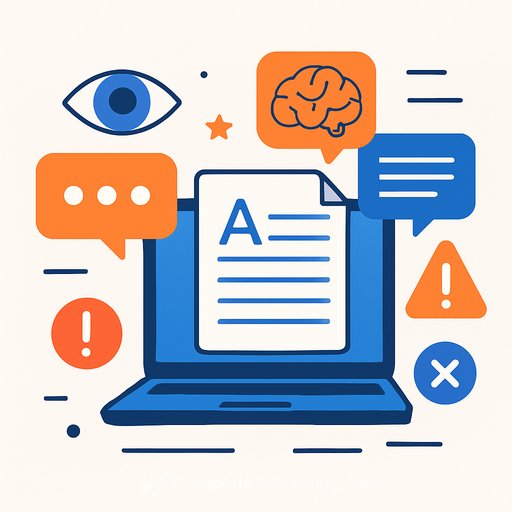Writers: Dependency on Chatbots Can Kill Synaptic Ignition
Write often and your brain wires for it. That's neuroplasticity - your brain reshapes itself through repeated, focused effort. Skip the work, and those circuits don't fire. Over time, they weaken.
AI makes it easy to outsource thinking. The output looks clean, but your brain stays idle. For a writer, that trade is deadly: fewer reps, fewer sparks, less originality.
Why convenience dulls your edge
Each time you wrestle with a hook, a metaphor, or a structure problem, your neurons strengthen their connections. That repeated firing is the "synaptic ignition" that builds your voice and speed. Offload those reps and you accumulate what many call cognitive debt - short-term gains, long-term cost.
Neuroplasticity rewards deliberate struggle. Shortcuts feel efficient; they're often expensive in the end. If you want a career, not a quick post, protect the reps that make you sharper.
APA: Neuroplasticity (definition)
An operating system for AI-assisted writing
Use AI as a lever, not a crutch. Keep the thinking loops human, and the polishing loops machine.
- Pen-before-prompt (5 minutes): Freewrite your thesis, target reader, promise, and 3 supports. No AI until you own the idea.
- Outline by hand: Headline, intro angle, 3 sections, close. If you can't outline it, you can't write it.
- Draft-to-think (15-30 minutes): Write a rough first pass without AI. Messy is fine. This is synaptic ignition in action.
- AI as editor, not author: Ask for critiques, counterarguments, structure fixes, and clarity passes. Avoid "write it for me."
- Blind rewrite: After AI feedback, close the tab and rewrite from memory. You'll keep the insights, not the crutches.
- Read-aloud pass: Your ear catches what your eyes miss. Mark friction and simplify.
- Evidence loop: You find sources; AI helps summarize; you verify and paraphrase. No copy-paste thinking.
No-AI zones that keep your edge
- Hooks and headlines: These train taste. Write 10. Pick 1. Only then ask AI to punch it up.
- Core argument: Your claim, your logic. Use AI to attack it, not create it.
- Metaphors: Build from your own stories. Ask AI to stress-test, not invent.
- Closing paragraph: You earn the last word. Write it yourself.
Calibration: how much AI is too much?
- The 2:1 rule: Spend at least 2 minutes thinking/typing for every 1 minute prompting.
- The whiteboard test: Can you explain the piece, without notes, in 90 seconds? If not, you offloaded too soon.
- Revision ratio: If over 40% of your sentences survive from an AI draft, you're outsourcing style and thought.
Weekly training plan for synaptic ignition
- Mon-Thu: One 45-90 minute no-AI sprint. Outline + rough draft only.
- Fri: AI critique + blind rewrite. Read aloud and tighten.
- Sat: Collect 5 examples of writing you admire. Hand-copy 250 words. Note rhythm, verb choice, sentence length.
- Sun: Idea lab. 20 headlines, 5 angles worth pursuing next week.
Prompts that help you think (not skip thinking)
- Attack my argument: "List the top 5 counterarguments to this thesis. Be specific and cite likely objections from [my audience]."
- Structure stress test: "Suggest 2 alternative outlines that improve logical flow and remove repetition."
- Clarity compression: "Identify jargon and propose simpler phrasing without losing nuance."
- Reader first: "Given [reader's context], where will attention drop? Mark those spots and explain why."
Policy for teams and clients
- Define allowed uses: Research acceleration, critique, fact cross-checking, line edits.
- Define prohibited uses: AI-written core thesis, fabricated quotes, unverified stats, undisclosed AI ghostwriting.
- Create an audit trail: Keep prompts, sources, and revision notes. Great for QA and learning.
- Measure outcomes: Track time-to-draft, originality, reader retention, and revisions needed. Optimize for thinking quality, not just speed.
Red flags you're outsourcing your craft
- You start with a prompt instead of a premise.
- Your drafts look polished but feel empty when read aloud.
- You can't pitch the idea in a single, confident sentence.
- Edits are cosmetic, not structural. Taste isn't improving.
The bottom line
AI can scale output. Your brain composes the inputs that matter: taste, judgment, and original synthesis. Protect the reps that build those assets.
Use AI to tighten, challenge, and accelerate - never to skip the work that wires your mind.
Helpful resources
- APA: Neuroplasticity (definition)
- Curated AI tools for copywriting (use them without losing your edge)
Your membership also unlocks:






